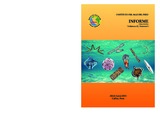Por favor, use este identificador para citar o enlazar este ítem:
https://hdl.handle.net/20.500.12958/2970| Título : | El fitoplancton de invierno en el crucero de estimación de biomasa de anchoveta 0708-09 |
| Otros títulos : | Phytoplankton of winter in the cruise of estimates the anchovy spawning biomass 0708-09 |
| Autor : | Delgado Loayza, Elcira Chang, Flor |
| Palabras clave : | Fitoplancton;Indicadores Biológicos;Biomasa |
| Fecha de publicación : | 2015 |
| Editorial : | Callao Instituto del Mar del Perú |
| Citación : | Inf Inst Mar Perú 42(2), 2015. p. 166-171 |
| Citación : | Informe IMARPE;Vol. 42, N° 2 |
| Resumen : | Los volúmenes de plancton superficial fluctuaron entre 0,06 y 11,14 mL.m-3
localizados frente a Pisco y Paita, respectivamente, registrando un promedio general de 1,34 mL.m-3. El
fitoplancton en superficie predominó en el 31% del área evaluada. El microplancton estuvo caracterizado por
diatomeas pequeñas de afloramiento (Chaetoceros sociales, Ch. compressus, Ch. lorenzianus, Skeletonema costatum)
y por especies de la fase intermedia de la sucesión (Coscinodiscus perforatus, C. centralis, Thalassionema frauenfeldii,
Lithodesmium undulatum). La presencia de especies termófilas también fue representativa encontrándose cerca
y lejos de la costa, destacando por su abundancia las diatomeas Planktoniella sol, Proboscia alata f. gracillima y
Thalasiothrix longissima. La correlación significativa entre la biomasa planctónica y oxígeno (r=>0,5) sugirió una mayor actividad autotrófica en las zonas norte y sur. El indicador de ACF, Protoperidinium obtusum, presentó una distribución costera con una amplitud máxima hasta las 120 mn al sur de Chicama y Atico y C.
praelongum indicador de ASS sólo fue registrado a 70 mn frente a Pucusana. ABSTRACT: Surface plankton volumes varied between 0.06 and 11.14 mL.m-3, located off Pisco and Paita, respectively, showing an overall average of 1.34 mL.m-3. The phytoplankton in surface predominated in 31% of the evaluated area. The micro plankton was characterized by small outcrop diatoms (Chaetoceros socialis, Ch. compressus, Ch. lorenzianus, Skeletonema costatum) and species of the intermediate phases of succession (Coscinodiscus perforatus, C. centralis, Thalassionema fraunfeldii, Lithodesmium undulatum). The presence of thermophilic species representative was also found near and from the coast, highlighted by its abundance of diatoms Planktoniella sol, Proboscia alata v. gracillima and Thalassiothrix longissima. The significant correlation between the plankton biomass and oxygen (r=>0.5) suggests greater autotrophic activity in the northern and southern areas. The indicator of Cold Coastal Waters (ACF), Protoperidinium obtusum, was localized in the coastal zone with maximum amplitude to the 120 mn to the south of Chicama and Atico, and Ceratium praelongum, indicator of Superficial Subtropical Waters (SSW), only was registered only 70 mn against Pucusana. |
| Descripción : | p. 166-171 |
| URI : | https://hdl.handle.net/20.500.12958/2970 |
| Aparece en las colecciones: | Informe vol. 42(2) 2015 |
Ficheros en este ítem:
| Fichero | Descripción | Tamaño | Formato | |
|---|---|---|---|---|
| INFORME VOL 42 (2)-4.pdf | 6,27 MB | Adobe PDF |  Visualizar/Abrir |
Este ítem está sujeto a una licencia Creative Commons Licencia Creative Commons

